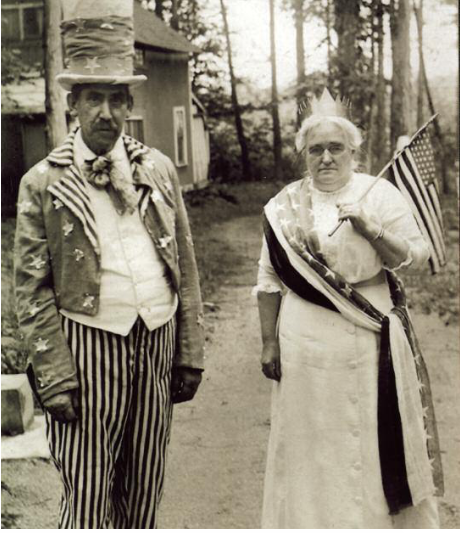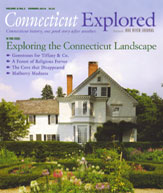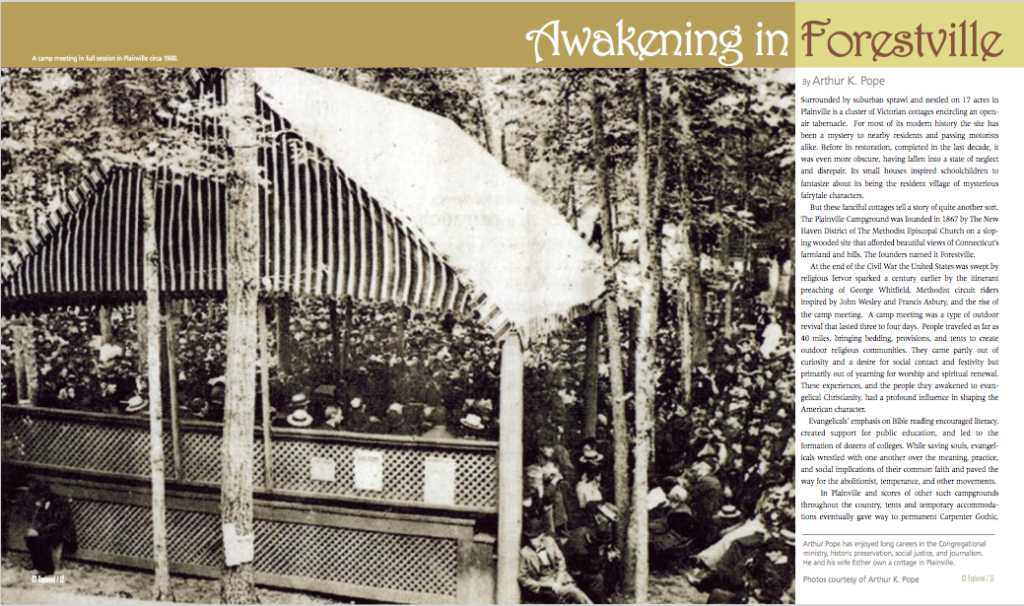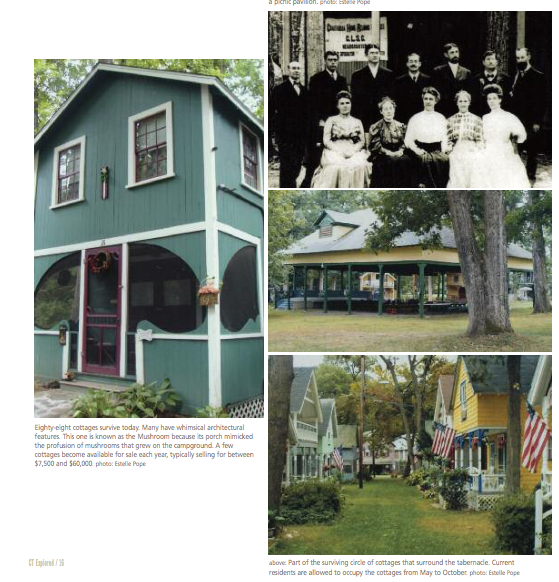(c) Connecticut Explored Inc. Summer 2010
Surrounded by suburban sprawl and nestled on 17 acres in Plainville is a cluster of Victorian cottages encircling an open-air tabernacle. For most of its modern history the site has been a mystery to nearby residents and passing motorists alike. Before its restoration, completed in the last decade, it was even more obscure, having fallen into a state of neglect and disrepair. Its small houses inspired schoolchildren to fantasize about its being the resident village of mysterious fairytale characters.
But these fanciful cottages tell a story of quite another sort. The Plainville Campground was founded in 1867 by The New Haven District of The Methodist Episcopal Church on a sloping wooded site that afforded beautiful views of Connecticut’s farmland and hills. The founders named it Forestville.
At the end of the Civil War the United States was swept by religious fervor sparked a century earlier by the itinerant preaching of George Whitfield, Methodist circuit riders inspired by John Wesley and Francis Asbury, and the rise of the camp meeting. A camp meeting was a type of outdoor revival that lasted three to four days. People traveled as far as 40 miles, bringing bedding, provisions, and tents to create outdoor religious communities. They came partly out of curiosity and a desire for social contact and festivity but primarily out of yearning for worship and spiritual renewal. These experiences, and the people they awakened to evangelical Christianity, had a profound influence in shaping the American character.
Evangelicals’ emphasis on Bible reading encouraged literacy, created support for public education, and led to the formation of dozens of colleges. While saving souls, evangelicals wrestled with one another over the meaning, practice, and social implications of their common faith and paved the way for the abolitionist, temperance, and other movements.
In Plainville and scores of other such campgrounds throughout the country, tents and temporary accommodations eventually gave way to permanent Carpenter Gothic, Eastlake, and Stick-style cottages encircling a tabernacle, dining hall, library, and other buildings. By 1901,as many as five thousand people gathered each summer at Forestville, many of them traveling by train.

Deacon John Allen at Forestville. He said he went to the Maine camp meeting in 1825 “a bold blatant rum drinking fun making Universalist and came away a red-hot shouting Methodist.” At his death at 92 he had attended 374 camp meetings. Courtesy of Arthur Pope
As the years passed, the idyllic grounds hosted ever-larger gatherings, sparked by the participation of several other local and national organizations such as the American Temperance Movement, the Grand Army of the Republic (forerunner of today’s veterans’ movement), Seventh Day Adventists, Forestville Camp and Bible Conference, and perhaps most famous of all, the Connecticut Chautauqua. While Connecticut had a number of other campgrounds, some of which still survive, it was the presence of Chautauqua at Plainville that gave this particular camp its larger significance.
Chautauqua had been founded in New York State in August 1874 by Lewis Miller and John Vincent on a former Methodist campground. It became a summer lyceum, hosting high-quality lectures, concerts, and entertainment, a summer school for Sunday-school teachers, and a commencement center for a life-enriching four-year home-reading course (equivalent to a college degree today) By 1891 180,000 people across the nation had enrolled.
The Plainville chapter of Chautauqua drew thousands to hear governors, senators, and nationally prominent speakers and entertainers and to witness the graduation of the correspondence-course participants.
Since 1957 the site, now listed on the National Register of Historic Places, has belonged to the Plainville Campgrounds Association, a private organization that has no ties to Methodism or any of the other movements once associated with it. Most of the original, cottages and other buildings, now privately owned, have been lovingly restored, preserved, and maintained. This community, chartered and zoned as seasonal and residential, is committed to preserving its architectural heritage and its loose-knit social circle and maintains very limited connections to its religious and social history.
More information is available in the book The Heart Strangely Warmed: The Chautauqua and Methodist Campgrounds at Plainville Connecticut by Arthur K. Pope. Order on line at Trafford.com/06-0064 or by calling the author at (860) 227-6369.
Arthur Pope has enjoyed long careers in the Congregational ministry, historic preservation, social justice, and journalism. He and his wife Esther own a cottage in Plainville.
Additional notes:
Early campers stayed in tents. Current residents are allowed to occupy the cottages from May to October.
Built in 1902 in the Algiers style, the tabernacle could seat 1,000 people under its roof and several thousand more on the grounds and cottage porches. Today it is used as a picnic pavilion.
Eighty-eight cottages survive. Many have whimsical architectural features. One is known as the Mushroom because its porch mimicked the profusion of mushrooms that grew on the campground. A few cottages become available for sale each year, typically selling for between $7,500 and $60,000.
Hundreds of people would make their way by train from the state’s industrialized cities. Locals would transport the visitors from the station at the foot of Camp Street in wagons for a nominal fee. Local farmers, butchers, bakers, barbers, and other tradesmen profited by providing services to the crowds.
Graduates of the Chautauqua four-year course of home reading marched through the grounds behind a class banner through a golden gate at their graduation ceremony. Small children dressed in white led the way to the ceremony in which diplomas were to be awarded. A home reading class would gather at Plainville for graduation. 10,000 such classes were established in the first 20 years the course was offered. A quarter of these students lived in villages of fewer than 500 inhabitants. There were even a number of classes in prisons.
[The Glad Inn:] Leon Gladding was the campground’s caretaker for many years and was responsible for building stone bridges and walls throughout the grounds. He and his family lived in this cottage. The Chinese lanterns on the porch suggest this photo was taken during an annual illumination night, when the entire grounds were lit by ornate Chinese lanterns. Residents adorned the grounds and cottages with American flags and bunting, a common practice between 1890 and 1910 when Americans emerging from the Civil War and Reconstruction sought unity through patriotism.



